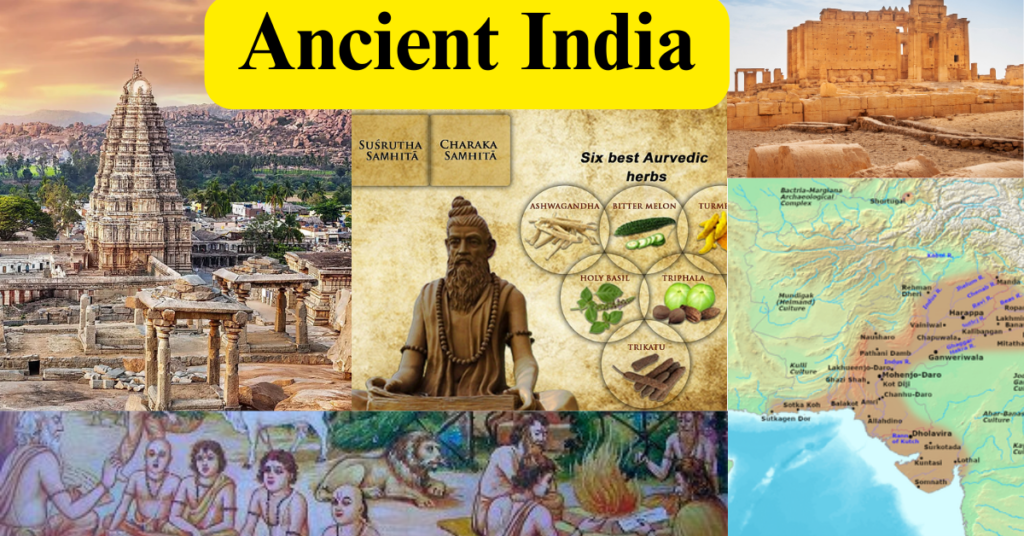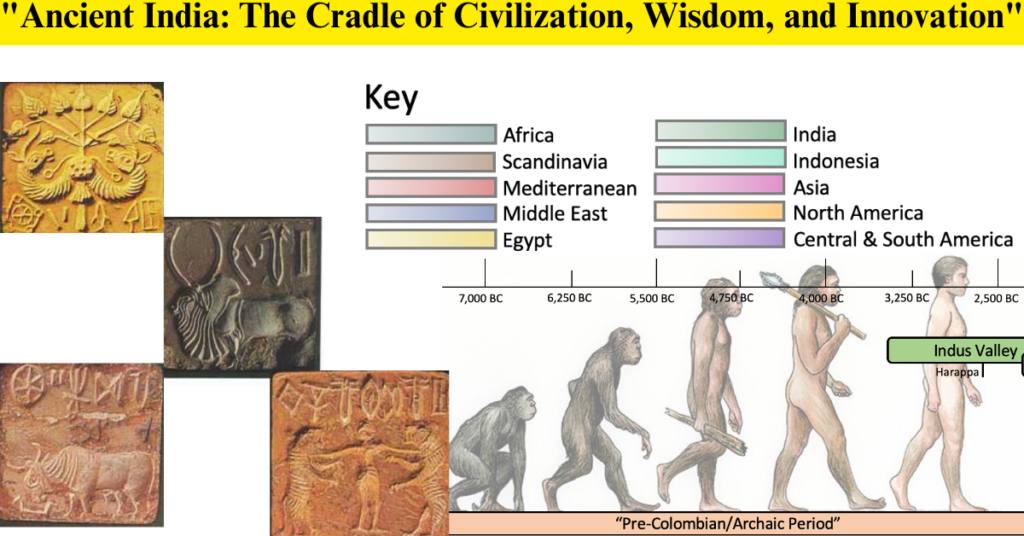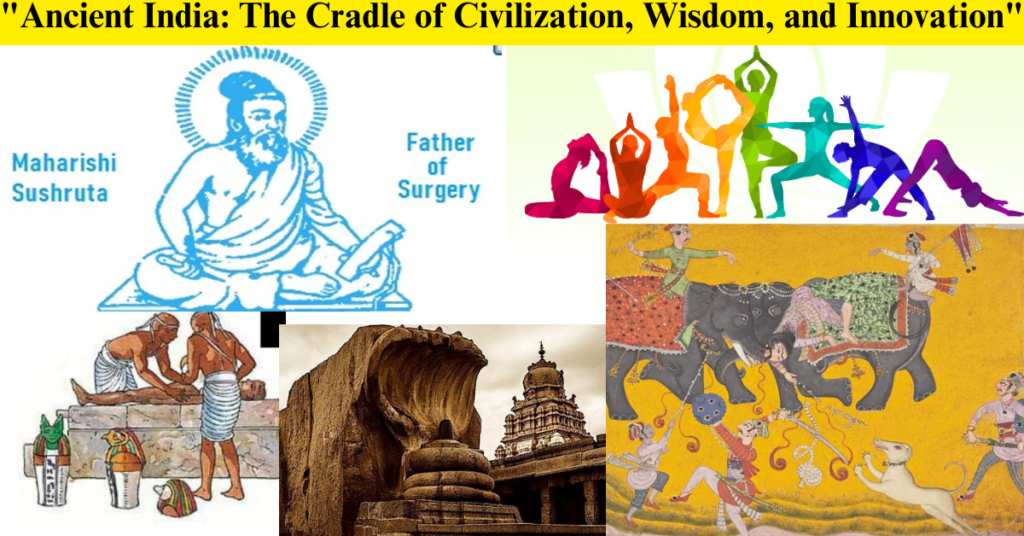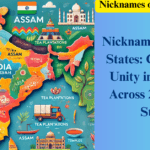
Table of Contents
“Ancient India: The Cradle of Civilization, Wisdom, and Innovation”
Introduction
Ancient India, a land of immense diversity and cultural richness, is one of the world’s oldest civilizations in the world . With a history that spans over several millennia, India has been a cradle of knowledge, science culture, and spirituality In the Indus Valley Civilization to the Vedic period, and from the rise of powerful empires to the development of profound philosophies and sciences, ancient India’s contributions to the world are monumental.
The Indus Valley Civilization

The story of ancient India starts with the Indus Valley Civilization (IVC), one of the earliest urban cultures in the world, flourishing around 2600 BCE to 1900 BCE. At present Located in what is now Pakistan and northwest India, the IVC was contemporary with ancient Egypt and Mesopotamia.
Major Cities and Urban Planning
The IVC is renowned for its advanced urban planning and sophisticated civil engineering. The major cities of Harappa and Mohenjo-Daro exemplify this. These cities were characterized by:
- Grid Layout: Streets laid out in perfect grids.
- Advanced Drainage System: Complex sewage and drainage systems, which were unparalleled in the ancient world.
- Public and Residential Buildings: Well-constructed residential areas, public baths, granaries, and warehouses.
Economy and Trade
The economy of the IVC was based on agriculture, supplemented by trade. The civilization was known for its:
- Agricultural Practices: Cultivation of wheat, barley, peas, and cotton.
- Trade Networks: Extensive trade with Mesopotamia, Persia, and Central Asia, indicated by the discovery of various artifacts.
Decline
The decline of the IVC remains a subject of scholarly debate. Possible reasons include environmental changes, such as shifts in river courses and climatic changes, or invasions by nomadic tribes.
Downfall
The downfall of the IVC remains a subject or topic of scholarly debate. Possible reasons include environmental changes, such as shifts in river courses and climatic changes, or invasions by nomadic tribes.
The Vedic Period
Following the downfall period of the IVC, the Vedic Period (circa 1500 BCE to 500 BCE) marked the arrival of the Indo-Aryans into the Indian subcontinent. This era is named after the Vedas, the oldest scriptures of Hinduism, composed during this period.
The Vedas and Religious Developments
The vedas are very important role play in this period The Vedas are a collection of hymns, prayers, and rituals that form the foundation of Vedic religion. The four Vedas—Rigveda, Samaveda, Yajurveda, and Atharvaveda—are the primary texts. Key aspects of this period include:
Vedic Rituals and Sacrifices:
Elaborate rituals and sacrifices (Yajnas) performed by priests (Brahmins).
Polytheism:
Worship of multiple deities, each associated with natural forces and elements.
Society and Social Structure
The Vedic society was organized into four varnas (social classes):
Brahmins: Priests and scholars.
Kshatriyas: Warriors and rulers.
Vaishyas: Merchants and landowners.
Shudras: Servants and laborers.
Early Political Structures
The Vedic period saw the formation of early political entities called Janapadas (tribal kingdoms). These entities eventually evolved into larger and more complex states.
The Rise of Major Kingdoms and Empires
The later Vedic period and the subsequent centuries witnessed the emergence of powerful kingdoms and empires that played crucial roles in shaping ancient India.
The Mahajanapadas
By the 6th century BCE, the Indian subcontinent was divided into sixteen major states known as Mahajanapadas. Among them, Magadha, Kosala, Vatsa, and Avanti were prominent.
The Maurya Empire
The Maurya Empire (circa 322 BCE to 185 BCE) was the first large-scale empire in India, founded by Chandragupta Maurya. Key highlights of this empire include:
- Administration: A centralized government with a complex bureaucracy.
- Ashoka the Great: Chandragupta’s grandson, Ashoka, expanded the empire to its zenith and later embraced Buddhism, promoting it throughout his realm and beyond.
Cultural and Intellectual Achievements
Ancient India was a hub of cultural and intellectual activities. Contributions in various fields such as religion, philosophy, science, and arts were profound and influential.
Religion and Philosophy

Ancient India was the birthplace of major world religions and philosophical traditions.
- Hinduism: Evolving from Vedic traditions, it developed complex rituals, a vast pantheon of deities, and philosophical schools like Vedanta and Yoga.
- Buddhism: Founded by Siddhartha Gautama (the Buddha) in the 5th century BCE, Buddhism emphasized the Middle Way and the Eightfold Path to enlightenment.
- Jainism: Founded by Mahavira, Jainism advocated non-violence (Ahimsa) and asceticism.
Science and Mathematics
Ancient Indian scholars made significant contributions to science and mathematics.
- Mathematics: The concept of zero, the decimal system, and significant advancements in algebra and geometry were developed.
- Astronomy: Scholars like Aryabhata and Varahamihira made pioneering contributions to astronomy and planetary motion.
Medicine
Ayurveda, an ancient system of medicine, was developed in India. Texts like the Charaka Samhita and Sushruta Samhita laid the foundations for medical science.
Literature and Arts
Ancient Indian literature and arts were immensely rich and varied.
- Literature: The two great epics, Mahabharata and Ramayana, and classical Sanskrit literature like Kalidasa’s works are timeless.
- Architecture and Sculpture: Temples, stupas, and cave paintings like those in Ajanta and Ellora are testimonies to the architectural and artistic brilliance.
The Gupta Empire: A Golden Age
The Gupta Empire (circa 320 CE to 550 CE) is often referred to as the Golden Age of India due to its remarkable achievements in various fields.
Political and Administrative Achievements
The Gupta rulers, particularly Chandragupta I, Samudragupta, and Chandragupta II, established a strong and prosperous empire characterized by:
- Efficient Administration: A well-structured administrative system and local governance.
- Military Conquests: Expansion of the empire through military conquests and diplomacy.
Cultural and Intellectual Flourishing
The Gupta period saw a flourishing of arts, science, and literature.
- Arts and Architecture: Development of classical art forms, including the creation of magnificent temples and sculptures.
- Science and Mathematics: Scholars like Aryabhata and Varahamihira made significant contributions, including Aryabhata’s approximation of pi and his work on solar and lunar eclipses.
Legacy and Influence
The legacy of ancient India is vast and far-reaching, influencing numerous aspects of modern civilization.
- Cultural Influence: Indian religions, particularly Buddhism, spread across Asia, influencing cultures and societies in China, Japan, Southeast Asia, and Tibet.
- Scientific Contributions: Ancient Indian contributions to mathematics, astronomy, and medicine continue to be acknowledged and respected globally.
- Philosophical and Ethical Teachings: The philosophical and ethical teachings of Hinduism, Buddhism, and Jainism have had a profound impact on global spiritual and ethical thought.
Conclusion
Ancient India’s rich and diverse and profound history is a testament to its profound contributions to human civilization. From the urban sophistication of the Indus Valley to the philosophical depth of the Vedic texts, and from the political might of the Maurya and Gupta empires to the cultural and scientific advancements, ancient India has left an indelible mark on the world. The enduring legacy of this ancient civilization continues to inspire and inform contemporary society, highlighting the timeless relevance of its wisdom and achievements.We are proud of India and being an indian because we are the part of this great land .






